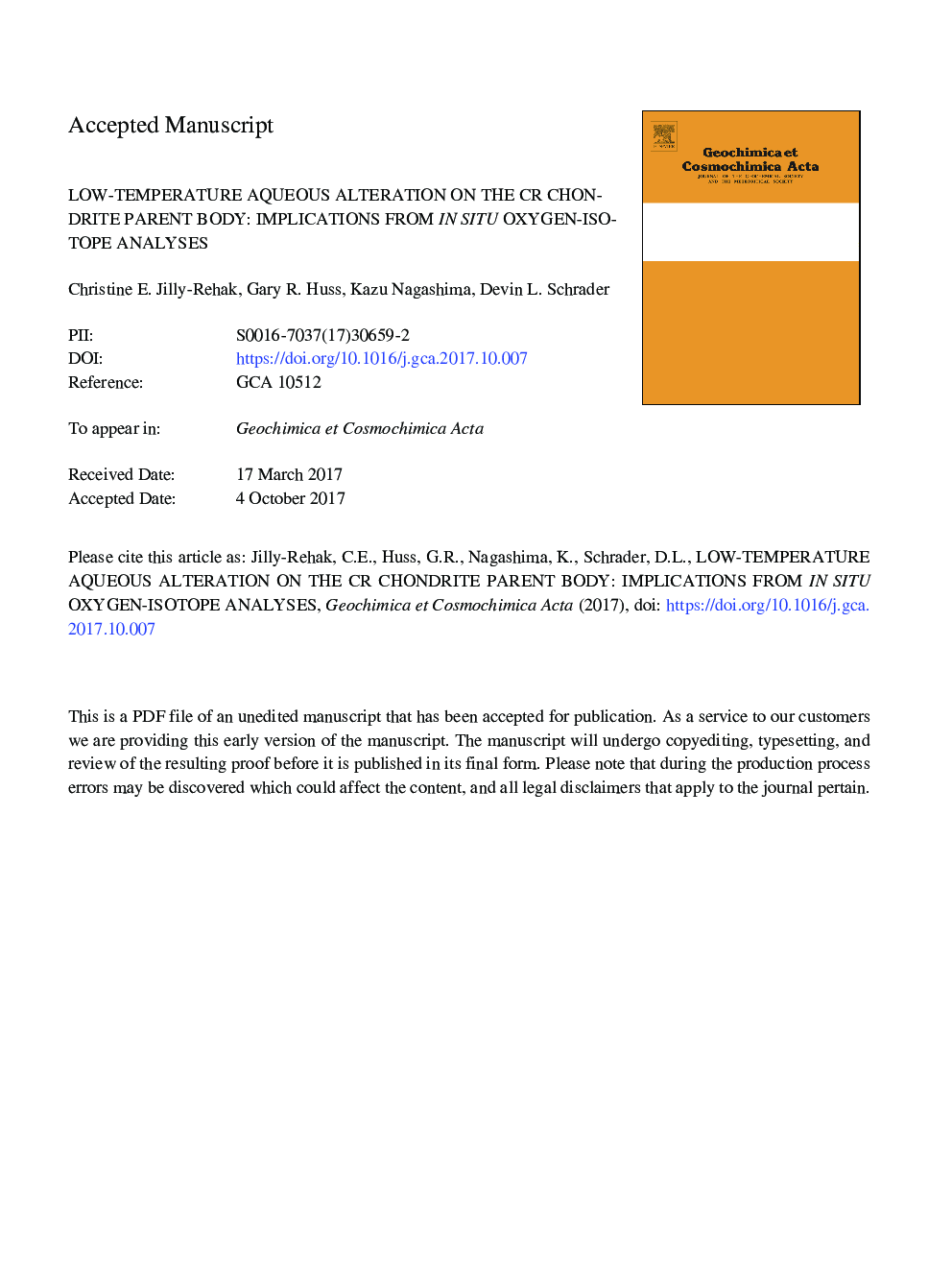| کد مقاله | کد نشریه | سال انتشار | مقاله انگلیسی | نسخه تمام متن |
|---|---|---|---|---|
| 8910942 | 1637935 | 2018 | 49 صفحه PDF | دانلود رایگان |
عنوان انگلیسی مقاله ISI
Low-temperature aqueous alteration on the CR chondrite parent body: Implications from in situ oxygen-isotope analyses
دانلود مقاله + سفارش ترجمه
دانلود مقاله ISI انگلیسی
رایگان برای ایرانیان
کلمات کلیدی
موضوعات مرتبط
مهندسی و علوم پایه
علوم زمین و سیارات
ژئوشیمی و پترولوژی
پیش نمایش صفحه اول مقاله

چکیده انگلیسی
The presence of hydrated minerals in chondrites indicates that water played an important role in the geologic evolution of the early Solar System; however, the process of aqueous alteration is still poorly understood. Renazzo-like carbonaceous (CR) chondrites are particularly well-suited for the study of aqueous alteration. Samples range from being nearly anhydrous to fully altered, essentially representing snapshots of the alteration process through time. We studied oxygen isotopes in secondary-minerals from six CR chondrites of varying hydration states to determine how aqueous fluid conditions (including composition and temperature) evolved on the parent body. Secondary minerals analyzed included calcite, dolomite, and magnetite. The O-isotope composition of calcites ranged from δ18Oâ¯ââ¯9 to 35â°, dolomites from δ18Oâ¯ââ¯23 to 27â°, and magnetites from δ18Oâ¯ââ¯â18 to 5â°. Calcite in less-altered samples showed more evidence of fluid evolution compared to heavily altered samples, likely reflecting lower water/rock ratios. Most magnetite plotted on a single trend, with the exception of grains from the extensively hydrated chondrite MIL 090292. The MIL 090292 magnetite diverges from this trend, possibly indicating an anomalous origin for the meteorite. If magnetite and calcite formed in equilibrium, then the relative 18O fractionation between them can be used to extract the temperature of co-precipitation. Isotopic fractionation in Al Rais carbonate-magnetite assemblages revealed low precipitation temperatures (â¼60â¯Â°C). Assuming that the CR parent body experienced closed-system alteration, a similar exercise for parallel calcite and magnetite O-isotope arrays yields “global” alteration temperatures of â¼55 to 88â¯Â°C. These secondary mineral arrays indicate that the O-isotopic composition of the altering fluid evolved upon progressive alteration, beginning near the Al Rais water composition of Î17Oâ¯â¼â¯1â° and δ18Oâ¯â¼â¯10â°, and becoming increasingly 16O-enriched toward a final fluid composition of Î17Oâ¯â¼â¯â1.2â° and δ18Oâ¯â¼â¯â15â°.
ناشر
Database: Elsevier - ScienceDirect (ساینس دایرکت)
Journal: Geochimica et Cosmochimica Acta - Volume 222, 1 February 2018, Pages 230-252
Journal: Geochimica et Cosmochimica Acta - Volume 222, 1 February 2018, Pages 230-252
نویسندگان
Christine E. Jilly-Rehak, Gary R. Huss, Kazu Nagashima, Devin L. Schrader,